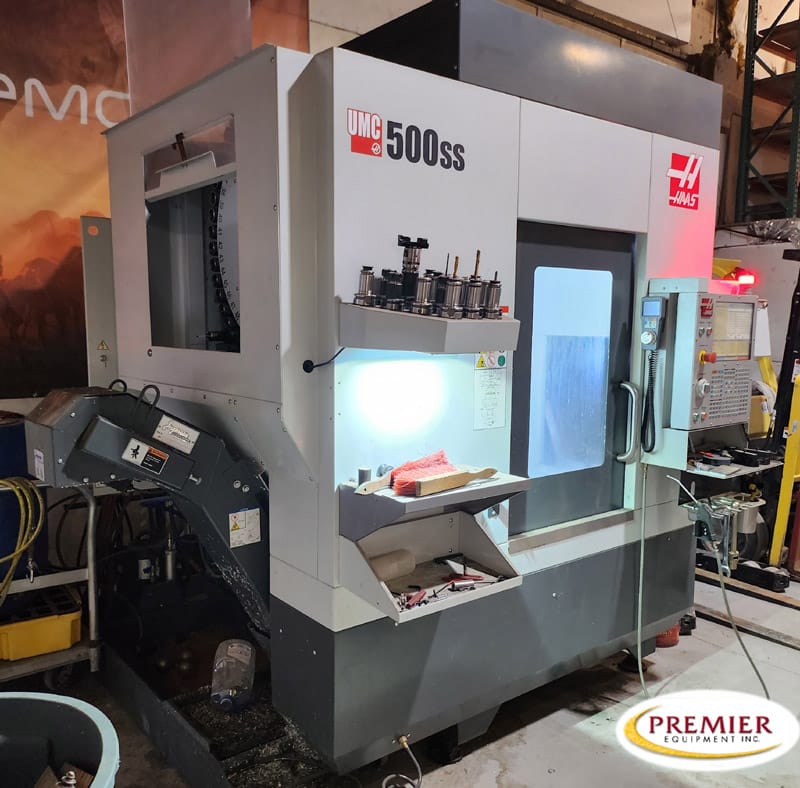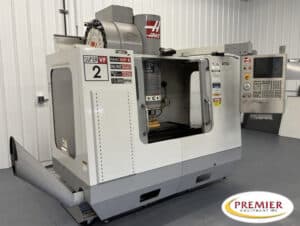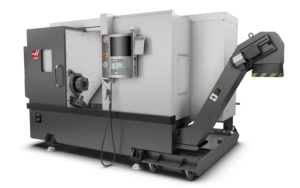In the world of manufacturing, 5-axis machining technology is a new development and ongoing improvement that has changed the way complex parts are made. Haas Automation, a leader in CNC machines, takes the lead in this innovation. In this article we will discuss the development of 5 axis machining technology in Haas CNC machines, their specifications and how they have revolutionized the manufacturing industry.
The Basics of 5-Axis Machining
On the other hand, 5 axis machining adds two additional rotational axes (A and B or C) to the traditional 3 axis CNC capabilities. This improvement allows the cutting tool to come at the workpiece from various angles, making it possible to machine complex parts with one setup. Fewer setups and repositioning are needed, resulting in better precision, and less time to produce complex shapes and features. It is this kind of capability that is critical in aerospace, automotive and medical device manufacturing where precision and complexity dominate.
Early Days of Haas and 5-Axis Machining
Founded in 1983 by Gene Haas, Haas Automation began by building affordable, high quality CNC machines. The company’s VF-1 vertical machining center was responsible for the company’s early success and became a new breed of CNC technology that offered both affordability and performance. Yet it wasn’t until the late 1990s that Haas started to explore 5 axis machining.
In 1987, Haas added 2-axis rotary tables to its product line, giving customers accessible 5-axis capability. It was Haas’s first foray into multi axis machining solutions.
On top of this foundation, Haas kept innovating in 5 axis machining. The UMC Series universal machining centers were developed by the company as cost effective solutions for 3+2 and simultaneous 5 axis machining. The UMC-750, for example, includes an integrated high speed, dual axis trunnion table for complex part machining with greater accuracy and fewer setups.
Today Haas Automation is known as a leading multi axis solution provider with a full range of 5 axis machining centers for all industry applications.
The First Steps: Haas UMC Series
When Haas Automation entered 5-axis machining, the Universal Machining Center (UMC) series introduced it. Designed to give users the flexibility to machine complex parts in a single setup, these machines were able to reduce production time and increase accuracy. The integrated high speed, dual axis trunnion tables of the UMC series provide cost effective 3+2 machining and simultaneous 5 axis machining with greater accuracy and fewer setups.
Haas UMC-750
One of the flagship models in the UMC series is the UMC-750. Key specifications include:
Travels:
- X-axis: 762 mm (30 in)
- Y-axis: 508 mm (20 in)
- Z-axis: 508 mm (20 in)
Spindle:
- Max Rating: 22.4 kW (30 hp)
- Max Speed: 8,100 rpm
- Max Torque: 122 Nm @ 2000 rpm
Rotary Axes:
- C-Axis Rotation: 360°
- B-Axis Tilt: +110° to -35°
Tool Changer:
- Capacity: 40+1 tools
Table:
- Diameter: 500 mm (19.7 in)
- Max Weight on Table: 300 kg (660 lbs)
The UMC-750 is a trunnion style rotary table which enables full 5 axis capability and is an attractive option for manufacturers who need to create intricate components with high precision.
Advancements and Innovations
The 5 axis machining capabilities of Haas Automation have been further developed, especially through the development of improved rotary tables. The improvements are higher load capacities, increased accuracy, smoother operation with reduced vibration, and overall higher precision. The HRT210SS Super Speed rotary table, for example, uses a heavy duty cycloidal drive system to index up to 490° per second, nearly five times faster than the standard HRT210. With its compact size and high speed capability, it is a perfect complement to high speed Haas machines such as the VF-2SS.
Furthermore, the redesigned TRT210 tilting rotary table provides a more compact and versatile 5-axis solution for mid size mills, fitting on one end of a machine’s table and leaving the rest open for additional fixture or vise.
With these advancements, Haas continues to show their dedication to bringing flexible and precise 5 axis machining solutions to production.
Haas UMC-1000
Expanding the UMC series, the UMC-1000 offers larger capacity and enhanced features. Key specifications include:
Travels:
- X-axis: 1,016 mm (40 in)
- Y-axis: 635 mm (25 in)
- Z-axis: 635 mm (25 in)
Spindle:
- Max Rating: 22.4 kW (30 hp)
- Max Speed: 8,100 rpm
- Max Torque: 122 Nm @ 2000 rpm
Rotary Axes:
- C-Axis Rotation: 360°
- B-Axis Tilt: +120° to -35°
Tool Changer:
- Capacity: 30+1 tools
Table:
- Diameter: 630 mm (24.8 in)
- Max Weight on Table: 454 kg (1,000 lbs)
The UMC-1000 caters to manufacturers requiring larger work envelopes while maintaining precision and efficiency.
The integration of advanced control systems, sophisticated coolant and lubrication mechanisms and seamless CAD/CAM software compatibility has helped Haas Automation to create revolutionary 5 axis machining.
Advanced Control Systems
Intuitive interfaces, advanced tool management, real time monitoring and simplified complex machining operations are all part of the Haas Next Generation Control (NGC). The Haas NGC has a user friendly interface with consistent navigation and intuitive icons, which makes the operation of complex tasks easier for operators. It also provides advanced tool management capability, capable of efficient tool organization and monitoring while machining. By implementing real time monitoring, operators will be able to track machine performance in real time and make adjustments to maintain an optimal machine performance on a prompt basis. Collectively, these features simplify complex machining operations and add overall improvement in productivity and precision.
Coolant and Lubrication systems referred to or explicitly described in the FAST Manual.
High speed machining requires sophisticated coolant and lubrication systems, which Haas has developed. P-Cool is a programmable coolant nozzle allowing for precise coolant direction and effective coolant and chip removal during cooling. Through Spindle Coolant (TSC) options aid chip evacuation by bringing coolant through the spindle, to the cutting tool, to improve cutting performance and tool life. Lubrication systems are improved to reduce thermal deformation, maintaining machine accuracy and extending component life.
Integration with CAD/CAM Software is demonstrated.
Today, Haas machines are being integrated seamlessly with a variety of CAD/CAM software packages allowing for direct programming from design files. Using this integration of design and production streamlines the workflow and decreases errors, all while improving efficiency. The control system of the machine allows operators to import design files directly to the machine and machine complex parts accurately and efficiently. This great integration helps improving the productivity as well as the quality of output in manufacturing process.
Impact on Complex Part Manufacturing
With the development of 5 axis machining technology in Haas CNC machines, many complex components able to be made is greatly improved in numerous industries.
Aerospace Industry
In aerospace, 5 axis machining is critical to the making of complex parts such as engine parts, turbine blades, and structural elements. The high precision and surface finishes needed for these critical components can be achieved on Haas machines. For example, the Haas VR Series VMCs are built for large, complex part machining and, therefore, are ideal for aerospace applications.
Automotive Industry
Engine blocks, cylinder heads, and transmission components are all parts that automotive manufacturers manufacture using 5 axis machining. These parts have been machined in a single setup, drastically reducing production times and improving part quality. For smaller parts, automotive applications benefit from the compact solutions of Haas’s UMC Series, such as the UMC-500, which provide 3+2 machining and simultaneous 5-axis machining.
Medical Device Manufacturing
5 axis machining is used in the medical device industry to create complex parts such as surgical instruments, orthopedic implants and dental parts. Haas machines provide the precision and accuracy necessary to meet the high quality standards. For instance, T&T Precision has used Haas UMC-750 Universal Machining Centres to machine complex shapes in a single setup, cutting labor times and improving tolerances that are critical for medical device manufacturing.
With these advancements in Haas’s 5 axis machining technology, manufacturers in many industries can now produce complex parts with greater precision, shorter production times and better quality, meeting the rigorous demands of industries such as aerospace, automotive and medical device manufacturing.
Challenges and Future Directions
5 axis machining has come a long way, however, there are still some challenges and future developments look promising to address them.
Operator Training
5 axis CNC machines are operated by the use of specialized skills including complex programming and advanced understanding of the machine functions. Haas also provides extensive training programs and support to train operators to have the know how. For example, the Haas Certification Program offers online courses that are intended to supply the fundamental knowledge needed to begin as a CNC machine operator or CNC machinist.
Technological Advancements
Emerging technologies like artificial intelligence, machine learning and the Internet of Things are setting the future of 5𝑥 machining. Predictive maintenance, process optimization and improved efficiency are expected to result. For instance, machining operations can utilize AI and machine learning in predictive modeling, in parameter optimization, and / or in control, as mentioned in the article Artificial intelligence enabled smart machining and machine tools.
Nevertheless, the 5 axis machining industry can continue to evolve to bring thousands of manufacturing issues through pin point accuracy and can be efficient and reliable in the manufacturing processes by introducing solutions for existing challenges and by availing technological advancements.
Haas UMC-500
Anticipating the need for compact solutions, Haas introduced the UMC-500, offering full 5-axis capability in a smaller footprint. Key specifications include:
Travels:
- X-axis: 610 mm (24 in)
- Y-axis: 406 mm (16 in)
- Z-axis: 406 mm (16 in)
Spindle:
- Max Rating: 22.4 kW (30 hp)
- Max Speed: 12,000 rpm (optional)
- Max Torque: 122 Nm @ 2000 rpm
Rotary Axes:
- C-Axis Rotation: 360°
- B-Axis Tilt: +110° to -35°
Tool Changer:
- Capacity: 30+1 tools
Table:
- Diameter: 400 mm (15.7 in)
- Max Weight on Table: 400 kg (880 lbs)
The UMC-500 is ideal for manufacturers with space constraints but who still require the capabilities of 5-axis machining.
Conclusion
A rapid evolution of 5-axis machining in Haas CNC machines has revolutionized manufacturing by allowing complex parts to be produced with unexampled precision and efficiency. The UMC-750, UMC-1000, and UMC-500 models represent Haas’s dedication to offering customized solutions to different manufacturing requirements.
Manufacturers in other industries will benefit from Haas’ continued innovation and what they can achieve beyond what we currently think is possible.



